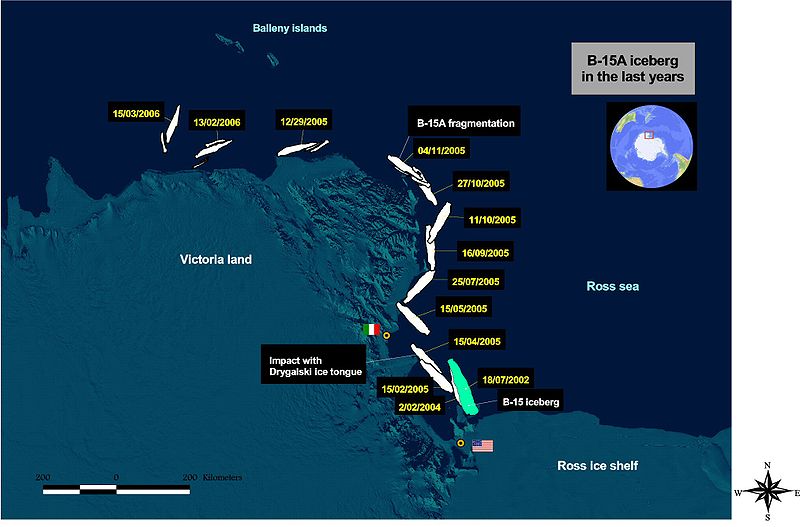B15 was the largest iceberg ever recorded to break away from Antarctica’s Ross Ice Shelf. That was in the year 2000. Now the iceberg is nearly gone.
| When ISS astronauts shot this photo on May 22, this chunk of iceberg B-15 measured 10 nautical miles long and 5 nautical miles wide, still within trackable size. It probably won’t be for long. |
Iceberg B-15 measured around 295 kilometres (183 mi) long and 37 kilometres (23 mi) wide (with a surface area of 11,000 square kilometres (4,200 sq mi)—larger than the whole island of Jamaica) when it broke from Antarctica in late March 2000. It’s still the biggest iceberg recorded so far from Antarctica’s Ross Ice Shelf. Now in its 18th year drifting with the currents – being battered by wind and sea – B-15 has since fractured into many smaller bergs, and most have melted away. Just four pieces of B-15 are still big enough to be tracked by the National Ice Center (at least 20 square nautical miles, or 69 square km). The photo at top – taken on May 22, 2018, by astronauts aboard the International Space Station – shows the piece of the original iceberg called B-15Z.
This chunk of ice – one of the only remaining pieces of the original iceberg – is likely nearing the end of its voyage. As these images show, there’s already a large fracture along the center of the berg, and smaller pieces are splintering off from the edges.
According to NASA’s Earth Observatory -
Melting and breakup would not be surprising, given the berg’s long journey and northerly location. A previous image showed B-15Z farther south in October 2017, after it had ridden the coastal countercurrent about three-quarters of the way around Antarctica bringing it to the Southern Ocean off the tip of the Antarctic Peninsula.
Currents prevented the berg from continuing through the Drake Passage; instead, B-15Z cruised north into the southern Atlantic Ocean. When the May 2018 photograph was acquired, the berg was about 150 nautical miles northwest of the South Georgia islands. Icebergs that make it this far have been known to rapidly melt and end their life cycles here.
| Satellite image from April 13, 2000. Iceberg B-15 broke from the Ross Ice Shelf in Antarctica in late March 2000. |
 |
| Iceberg B-15A four-year journey, March 2006 |
_(NSF).jpg/800px-Research_on_Iceberg_B-15A_by_Josh_Landis%2C_National_Science_Foundation_(Image_4)_(NSF).jpg) |
| Northern edge of Iceberg B-15A in the Ross Sea, Antarctica, 29 January 2002 |
Source - EarthSky.org
Read more at the Science Pole App
No comments:
Post a Comment